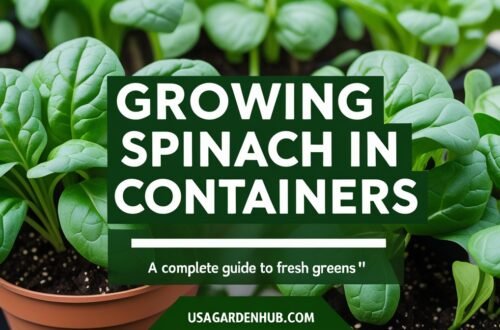Discover expert tips for growing bok choi in containers! Learn about soil preparation, planting techniques, pest management, and harvesting methods for a thriving container garden. Perfect for urban gardeners and beginners alike.
Bok choi, also known as pak choi or Chinese cabbage, is an excellent vegetable for container gardening. With its compact size and quick growth, bok choi can thrive in pots on balconies, patios, or small gardens. Key factors for success include choosing the right container, using well-draining soil, providing adequate sunlight, and consistent watering.
![Growing Bok Choi in Containers: A Simple Guide to Bountiful Harvests [2024 Update] 2 A vibrant container garden featuring lush bok choi plants growing in pots on a sunny patio. The containers are at least 6 inches deep, with healthy bok choi leaves reaching their full height. In the foreground, a gardener tends to the plants, ensuring they have consistent moisture and proper sunlight. Some containers have young bok choi seedlings just sprouting, showcasing the simplicity of growing in small spaces. Text overlay reads, 'Growing Bok Choi in Containers: Your 2024 Guide to Success.](https://usagardenhub.com/wp-content/uploads/2024/10/Bok-choi-574x1024.jpeg)
Hey there, urban gardeners and container enthusiasts! I’m Lisa, and I’ve been growing vegetables in containers for over a decade. Today, I’m excited to share my tips for growing delicious bok choi in pots. Trust me, once you taste homegrown bok choi, you’ll wonder why you didn’t start sooner!
1. Choosing the Right Container
![Growing Bok Choi in Containers: A Simple Guide to Bountiful Harvests [2024 Update] 3 A bright and inviting gardening scene showcasing various containers ideal for growing bok choi. In the foreground, a gardener is examining a selection of pots, including a deep, 12-inch wide ceramic pot and a stylish self-watering container with visible drainage holes. Some pots are filled with rich potting soil, ready for planting. Labels attached to each container highlight the recommended dimensions of at least 6 inches deep and 12 inches wide. The background features lush green bok choi plants thriving in similar containers, demonstrating successful growth. Sunlight filters through the leaves, creating a warm, vibrant atmosphere. A small chalkboard sign reads 'Choosing the Right Container for Bok Choi,' emphasizing the importance of container selection for healthy plants.](https://usagardenhub.com/wp-content/uploads/2024/10/pikaso_text-to-image_Candid-image-photography-natural-textures-highly-r-21-701x1024.jpeg)
Selecting an appropriate container is crucial for healthy bok choi. Here’s what I recommend:
- Use pots at least 6 inches deep and 12 inches wide
- Ensure containers have drainage holes
- Consider self-watering containers for consistent moisture
2. Preparing the Soil
![Growing Bok Choi in Containers: A Simple Guide to Bountiful Harvests [2024 Update] 4 A vibrant gardening scene focusing on the preparation of soil for growing bok choi. In the foreground, a gardener is mixing a high-quality potting mix in a large container, showcasing the rich, dark texture of the soil. Nearby, bags of compost and well-rotted manure are open, indicating they’re being added to the mix for enhanced nutrients. A handful of perlite or vermiculite is seen being incorporated into the soil to improve drainage, ensuring optimal growing conditions. The background features healthy bok choi seedlings in pots, illustrating the successful results of this soil preparation. Soft, natural light illuminates the scene, creating a warm and inviting atmosphere. A small sign reads 'Preparing the Soil for Bok Choi,' highlighting the importance of a nutrient-rich and well-draining mix.](https://usagardenhub.com/wp-content/uploads/2024/10/pikaso_text-to-image_Candid-image-photography-natural-textures-highly-r-22-701x1024.jpeg)
Bok choi thrives in rich, well-draining soil. Here’s my go-to mix:
- Use a high-quality potting mix, not garden soil
- Add compost or well-rotted manure for nutrients
- Incorporate perlite or vermiculite to improve drainage
3. Planting Bok Choi
![Growing Bok Choi in Containers: A Simple Guide to Bountiful Harvests [2024 Update] 5 A close-up gardening scene focused on planting bok choi. In the foreground, a gardener is sowing seeds into the soil, placing them 1/4 inch deep and about 2 inches apart. Nearby, seedlings are carefully spaced 6 inches apart and planted with their bases level to the soil surface. The rich soil, lush green leaves, and bright garden tools emphasize the hands-on aspect of growing bok choi. Soft, natural light filters through the garden, creating a fresh and productive atmosphere. Text overlay reads, 'Planting Bok Choi: Seeds & Seedlings.](https://usagardenhub.com/wp-content/uploads/2024/10/A_close-up_gardening_scene_foc.jpeg)
You can start bok choi from seeds or seedlings. Here’s how:
From Seeds:
- Sow seeds 1/4 inch deep, about 2 inches apart
- Thin seedlings to 6 inches apart when they’re 2 inches tall
From Seedlings:
- Plant seedlings 6 inches apart
- Ensure the base of the plant is level with the soil surface
4. Providing Proper Care
![Growing Bok Choi in Containers: A Simple Guide to Bountiful Harvests [2024 Update] 6 A peaceful garden setting showcasing thriving bok choi plants under optimal care. In the foreground, a gardener is applying a balanced water-soluble fertilizer, while another section shows well-watered soil with no water on the leaves. The bok choi is placed in a sunny spot, receiving 4-6 hours of direct sunlight, and shaded in the afternoon to prevent bolting. A moisture meter stands nearby, helping to maintain ideal soil moisture levels. Text overlay reads, 'Caring for Bok Choi: Sun, Water, and Nutrients.](https://usagardenhub.com/wp-content/uploads/2024/10/A_peaceful_garden_setting_show.jpeg)
Bok choi is relatively low-maintenance, but it does have some specific needs:
Sunlight Requirements:
- Provide 4-6 hours of direct sunlight daily
- In hot climates, offer afternoon shade to prevent bolting
Watering:
- Keep soil consistently moist but not waterlogged
- Water at the base of plants to avoid wetting leaves
- Consider using a moisture meter for precise watering
Fertilizing:
- Feed with a balanced, water-soluble fertilizer every 2-3 weeks
- Alternatively, use a slow-release fertilizer at planting time
5. Managing Pests and Diseases
![Growing Bok Choi in Containers: A Simple Guide to Bountiful Harvests [2024 Update] 7 A detailed gardening scene focused on protecting bok choi plants from pests and diseases. In the foreground, a gardener is spraying neem oil to combat aphids, while nearby row covers are placed over plants to prevent flea beetle damage. Diatomaceous earth is scattered around the plants to keep pests at bay. Bok choi plants are spaced well for good air circulation, with the gardener removing yellowing leaves to prevent disease. Text overlay reads, 'Managing Pests & Diseases: Protect Your Bok Choi.](https://usagardenhub.com/wp-content/uploads/2024/10/a-detailed-gardening-scene-focused-on-protecting-b-_wPWZCXuQASCrUQMUThCAg-dBGBC1CbQfiD1iYO9uxujQ-574x1024.jpeg)
Bok choi can be susceptible to certain issues. Here’s how I handle them:
Common Pests:
- Aphids: Spray with neem oil or insecticidal soap
- Flea beetles: Use row covers or diatomaceous earth
Disease Prevention:
- Ensure good air circulation between plants
- Avoid overhead watering to prevent fungal diseases
- Remove any yellowing or diseased leaves promptly
6. Harvesting Bok Choi
![Growing Bok Choi in Containers: A Simple Guide to Bountiful Harvests [2024 Update] 8 A satisfying garden scene showing the harvest of mature bok choi plants. In the foreground, a gardener carefully cuts the entire plant at the base, while another plant shows a few outer leaves being picked for continuous harvest. The bok choi plants stand 6-8 inches tall, healthy and vibrant, ready for harvesting 4-6 weeks after planting. A basket of freshly harvested bok choi sits nearby, emphasizing the reward of homegrown produce.](https://usagardenhub.com/wp-content/uploads/2024/10/a-photo-of-a-garden-with-mature-bok-choi-plants-in-ekD7Yzu9SrSiP6fYktJnSQ-YJ2StR9xQ0SQtEWsCi17yA-574x1024.jpeg)
The best part – enjoying your homegrown bok choi! Here’s when and how to harvest:
- Harvest when plants are 6-8 inches tall, usually 4-6 weeks after planting
- Cut the entire plant at the base for a one-time harvest
- For a continuous harvest, pick outer leaves as needed
7. Succession Planting
![Growing Bok Choi in Containers: A Simple Guide to Bountiful Harvests [2024 Update] 9 A productive garden scene showcasing the practice of succession planting for bok choi. In the foreground, a gardener plants new seeds and seedlings every 2-3 weeks, with mature bok choi plants growing nearby. The scene emphasizes the consistent planting schedule, ensuring a steady supply before temperatures rise above 75°F (24°C). In the background, young bok choi plants are thriving under late-summer sunlight, preparing for a fall crop. Text overlay reads, 'Succession Planting for Bok Choi: Steady Harvest All Season.](https://usagardenhub.com/wp-content/uploads/2024/10/a-photo-of-a-productive-garden-scene-with-successi-iGPK5WLsT2ShAs9hLj0yVA-RQ-NQpKkT3S4qywbol6JyA-574x1024.jpeg)
To ensure a steady supply of bok choi:
- Plant new seeds or seedlings every 2-3 weeks
- Continue planting until temperatures consistently rise above 75°F (24°C)
- Resume planting in late summer for a fall crop
8. Overwintering Bok Choi
![Growing Bok Choi in Containers: A Simple Guide to Bountiful Harvests [2024 Update] 10 A winter garden scene featuring bok choi plants protected from frost with row covers and cold frames. In the foreground, a gardener moves containers of bok choi to a sheltered location during extreme cold, ensuring the plants survive throughout winter. The bok choi thrives under protection, with frost-resistant varieties growing strong. Snow gently dusts the garden, emphasizing the need for cold protection. Text overlay reads, 'Overwintering Bok Choi: Year-Round Growth in Mild Climates.](https://usagardenhub.com/wp-content/uploads/2024/10/a-photo-of-a-winter-garden-with-bok-choi-plants-pr-nEEofSkxQ22oTBe0oser9Q-ZTt5ml29RVmH5FjKInXpkg-574x1024.jpeg)
In mild climates, you can grow bok choi year-round:
- Provide protection from frost with row covers or cold frames
- Move containers to a sheltered location during extreme cold
- Choose cold-hardy varieties for best results
Growing bok choi in containers is a rewarding experience that can provide you with fresh, nutritious greens in just a few weeks. With the right container, soil, and care, you can enjoy multiple harvests throughout the growing season. Remember, every garden is unique, so don’t be afraid to experiment and find what works best for your space and climate.
Happy container gardening, and enjoy your homegrown bok choi!
For more gardening tips and plant care guides, visit usagardenhub.com.

![Growing Bok Choi in Containers: A Simple Guide to Bountiful Harvests [2024 Update] 1 A vibrant container garden featuring lush bok choi plants growing in pots on a sunny patio. The containers are at least 6 inches deep, with healthy bok choi leaves reaching their full height. In the foreground, a gardener tends to the plants, ensuring they have consistent moisture and proper sunlight. Some containers have young bok choi seedlings just sprouting, showcasing the simplicity of growing in small spaces. Text overlay reads, 'Growing Bok Choi in Containers: Your 2024 Guide to Success.](https://usagardenhub.com/wp-content/uploads/2024/10/Bok-choi.jpeg)


